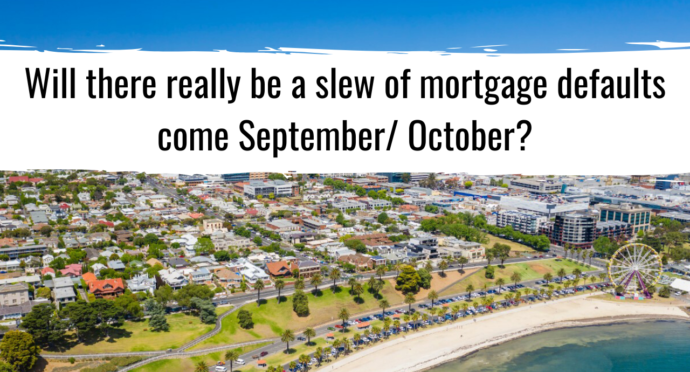I’ve seen a number of quite alarming headlines recently that there’s going to be a wave of mortgage defaults in September/ October once the relief measures like Jobkeeper and loan repayment deferrals end simultaneously.
Here’s an alternative point of view…
Firstly, readers can take comfort that the Australian Prudential Regulation Authority (APRA) and the banking industry are currently in discussions about avoiding the impact of something like this happening.
A number of solutions are being examined including enabling certain borrowers to extend their mortgage deferrals for a further six months.
This mightn’t be easy for the banks to administer, particularly if the extension process moves more towards case by case assessments of individual customer positions, however as APRA chairman Wayne Byres told a Senate committee last month no one has an interest in ‘going off the cliff’.
Like many of the mainstream market analysts, I can’t see the government allowing us to fall off this proverbial cliff, not given the strength of our budget going into the crisis, and not given sheer amount of time, money, effort and publicity which has already gone into getting us through.
Consumer confidence is paramount to resurrecting the economy and from what we’ve seen so far it appears the government is going to great measures to maintain it.
National Australia Bank CEO Ross McEwan recently advised that at the half way mark of the mortgage deferral scheme about 10 – 15 per cent of NAB customers who initially elected to pause their loan repayments have asked to be put back onto their normal payment schedule now (see here).
Also there have been suggestions that up to 20 per cent of customers who were granted loan deferrals when they first contacted their lenders didn’t end up using them.
They just kept making regular repayments because their financial situations allowed them to.
In relation to mortgage stress, which is what leads to defaults, studies have found the highest incidence of stress occurs in lower socio-economic areas.
In Melbourne, it is least evident in more affluent inner city, bayside and middle-distance eastern suburbs.
Findings like this resemble a higher rate of employment vulnerability in lower socio-economic areas, as well as larger mortgages proportionate to the average income and asset bases of borrowers in those areas.
Another example of how certain sub-markets are impacted differ ently comes when you look at the benchmark ‘definition’ for mortgage stress in Australia – borrowers who allocate over 30% of their net income after tax towards repayments.
If a high income earning couple allocates 40 per cent of their net after tax income to mortgage repayments, they may still have vast amounts of surplus cash each year, I don’t think it’s accurate to assume they are in mortgage stress and therefore at a higher risk of defaulting on their loan.
Similarly, another borrower might allocate 50 per cent of their after tax income to their mortgage, but if they’ve got hundreds of thousands of dollars in cash and shares, they may not be financially stressed at all.
It’s also worth noting that according to Corelogic approximately one third of Australian households have no mortgage debt, and as at October 2019 the loan ratio of residential real estate in Australia as a whole is below 30 per cent (see chart pack here) – with an inverse relationship existing between loan ratios and default rates.
Plus for those households who do have a mortgage, affordability has benefited a lot recently from record low interest rates.
Readers may also take comfort that according to the Reserve Bank of Australia (RBA) the mortgage arrears rate in Australia is only about 1 per cent (see here) – this is low both by historical and international standards – in the United States arrears peaked at 10 per cent during the global financial crisis.
Borrowers in Australia tend to go to great lengths to avoid default and reasons for this include the strong social stigma, limited options for credit-impaired borrowers, and minimal non-recourse lending.
A non-recourse loan means the bank only has access to the home the mortgage is on to recover any outstanding debts – it can sell the property to recover as much as it can, but can’t access the borrower’s other savings or assets.
Aside from certain borrowing arrangements within self managed super funds, such non-recourse loans don’t really exist in Australia (they are much more common in other countries like the United States).
The standard mortgage contract in Australia gives the bank full recourse – if you default on the loan then the bank can not only sell the property, but also get a court judgment to go after your other assets and even send you bankrupt!
Therefore when borrowers do face mortgage stress in Australia, they are far more likely to source additional income, cut back on all other expenses, seek other forms of assistance, potentially sell other assets, etc. before defaulting.
In summary, my personal view is that many of the headlines around mass mortgage defaults in September/ October are exaggerated, and rather than impacting all suburbs equally, instances of higher stress will be more likely where there is a concentration of both higher leverage and higher employment vulnerability.
Also, it is hard to imagine the government and banks not extending further relief to maintain confidence in Australia, until this crisis is really over.
—
Long Property blog content provides general information only and has been prepared without taking into account your objectives, financial situation or needs. We recommend that you consider whether it is appropriate for your circumstances and your full financial situation will need to be reviewed prior to acceptance of any offer or product. Nothing on the Long Property website constitutes legal, tax or financial advice and you should always seek professional advice in relation to your individual circumstances.




